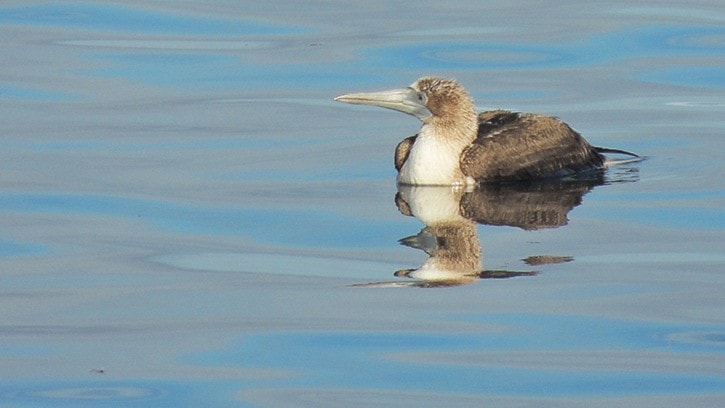North Vancouver Island is known for a diversity of wildlife across the aquatic, avian and land-based.
That diversity was stretched to new limits late in September with a virtually unprecedented sighting of a blue-footed booby in Johnstone Strait, followed just two days later by the arrival of an uncommon Mola Mola — a species of ocean sunfish — in the Western Forest Products dryland sort operation in Port McNeill.
The blue-footed booby was spotted by crew and passengers aboard the Stubbs Island Whale Watching boat M/V Kuluta on Sept. 24, near Stubbs Island. Coincidentally, several passengers aboard that sailing were birders and they confirmed the sighting, which is extremely rare in this region.
The blue-footed booby — identifiable by a long, pointed beak, yellow irises and its distinctive bright blue, webbed feet, is a seabird typically found in tropical and sub-tropical regions of the Pacific Ocean, in a range from Southern California to Peru. About half of all breeding pairs nest on the Galapagos Islands. To get an idea how rare the bird is in Canadian waters, NBC Southern California published an online article just five days prior to the Stubbs Island sighting, headlined “Rare Blue-Footed Booby Mysteriously Appears in LA County”. The article said the birds were spotted in Los Angeles County for the first time since 2007.
Two days after that find, the less rare — but still uncommon — Mola Mola surprised workers arriving to start their shift at the dryland sort in Port McNeill.
“I just said, ‘Holy cow, there’s something weird in the water,’” said Terry Bishop, a boom man who spotted the nearly eight-foot-long Mola Mola almost against the shore before alerting co-workers. “I’d never seen one before.”
The last reported sighting of a Mola Mola, the world’s largest bony fish, in this area was a dead specimen that washed up in Hardy Bay near Port Hardy almost exactly two years ago.
Crew members took photos and videos of the big fish, which is sometimes referred to as a basking shark due to its prominent dorsal fin and tendency to lay on its side at the surface. The Mola Mola is made up of a huge head and a narrow, tapered body that ends just behind the dorsal and anal fins, appearing as though it has no tail.
The Mola Mola found in Port McNeill was still alive, but the workers were concerned it was sickly and made a decision to tow it out of the “bull pen” and into open water.
“I didn’t want him to get bombed by a (log) pile,” said Doug Engel, another boom man, but Bishop admitted workers were also concerned it would die in the pen and take several smelly weeks to decompose.
The boom men tried to hook the fish with a pike pole from the back of a boom boat, but its thick, hard skin proved impervious to the spike. They then tried hooking the pike in its mouth, and it bit down.
“I could feel its teeth grinding on the pole,” said Engel. “I turned around said, go!”
It was pulled from the bull pen into Port McNeill Bay and released. It was spotted a short time later near the small marina near the end of the breakwater but then disappeared from view for about an hour.
Then, it surfaced again, identifiable by its large fin, in the open water between the log sort’s breakwater and Port McNeill Harbour.
Seemingly unafraid of people, it coasted right up to Engel’s boom boat and nosed the craft before submerging again, tail first.
